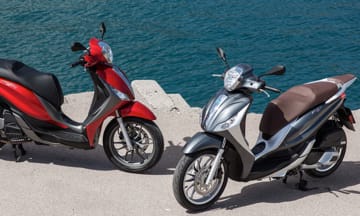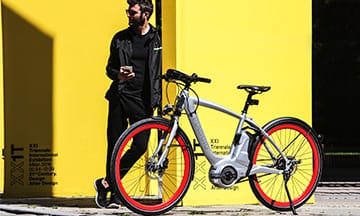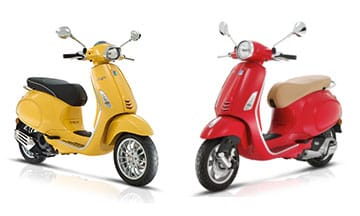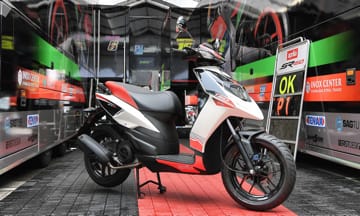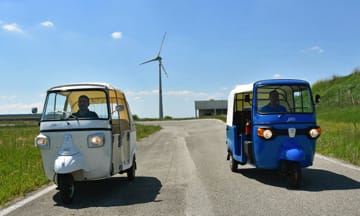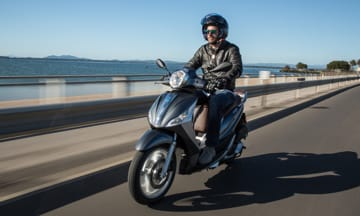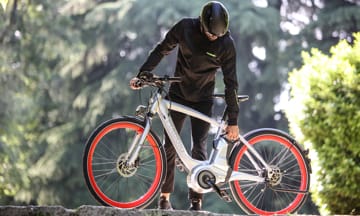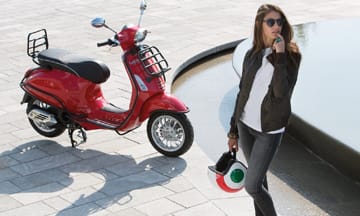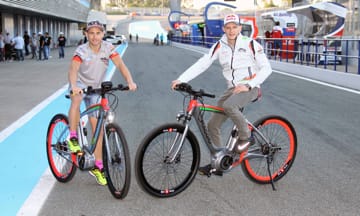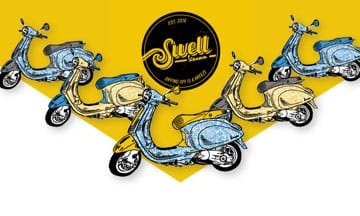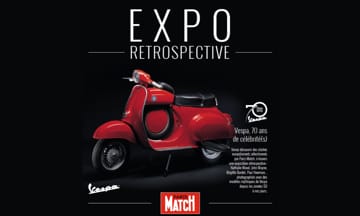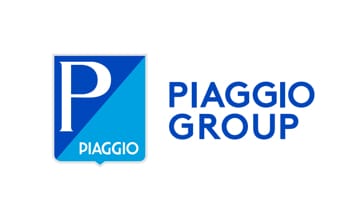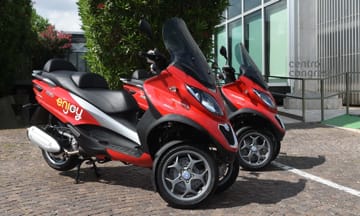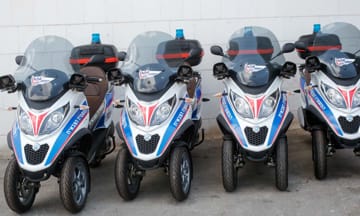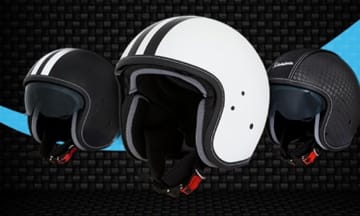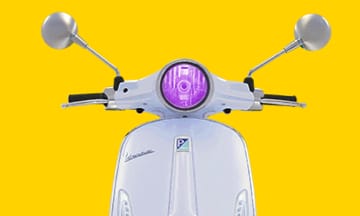
NEW PIAGGIO MEDLEY:
BORN LEADER
PIAGGIO MEDLEY IS THE NEW EASY SCOOTER, FULLY LOADED AND TECHNOLOGICALLY ADVANCED, THAT COMBINES THE BENEFITS OF A LIGHTWEIGHT HIGH WHEEL WITH THE COMFORT AND FEATURES OF A SUPERIOR CLASS SCOOTER.
PIAGGIO MEDLEY IS POWERED BY THE NEW iGET 125 AND 150 CC ENGINES, ELECTRONICALLY FUEL INJECTED, LIQUID COOLED AND WITH 4 VALVE TIMING. A NEW FAMILY OF SINGLE CYLINDER ENGINES THAT RAISES THE BAR IN TERMS OF QUALITY, RELIABILITY AND EMISSIONS CONTAINMENT.
START & STOP, ABS, LIGHT CLUSTERS WITH LED TECHNOLOGY, RECORD CARGO CAPACITY: PIAGGIO MEDLY WAS BORN TO BE A LEADER, EMBODYING THE VALUES OF QUALITY, STYLE AND TECHNOLOGY.
The agility of a metropolitan vehicle combined with the dynamic character of a high wheel and the convenience and cargo capacity of a large GT scooter GT resulted in the Medley, the new Piaggio that combines ultra-modern values of rationality, technology and style. Medley blends practicality, technical innovation and beauty in the purest Italian style, fully comprehending the continuously evolving needs of a public in search of mobility solutions that go beyond the usual scooter formula. With Medley nothing is sacrificed. Piaggio Medley skilfully combines the benefits of a chassis characterised by large diameter wheels, which guarantee superior rideability and road holding compared with smaller wheeled scooters, and the rationality of a classic scooter, its protection, its cargo capacity, the comfort of its large saddle when riding two-up.
The high wheel scooter has been very successful, divided up into lightweight and manoeuvrable vehicles characterised by an easy ride and economic operating costs, and more important vehicles with qualities such as sturdiness and performance. Piaggio, the European leader among major global scooter manufacturers, a company with a unique heritage as the creator of new forms of light mobility, has been a protagonist in the high wheel segment with both easy and lightweight scooters such as the Liberty, as well as with scooters that have spectacular performance and exclusive technical features such as the Beverly range. Medley achieves the goal of creating a new class of Piaggio high wheel scooter that combines the benefits of an agile and lightweight scooter with those of a larger and higher performance high wheel. Coming standard with the “Start & Stop” feature which, by managing engine switch-off and start-up during stops, contributes to containing fuel consumption and emissions as well as two-channel ABS, Piaggio Medley therefore boasts an equipment package that is normally reserved for superior class scooters. Two 4-stroke engines from the new i-get family are available - 125 and 150 cc - both liquid cooled with 4 valve timing and electronic fuel injection. This is a new family of engines designed and developed by Piaggio which boasts a scooter engine research and development centre, one of the most advanced in the world.
STURDY, EASY TO RIDE AND LIGHTWEIGHT
The bearing structure of the Piaggio Medley is based on a new “low single cradle” type frame made of steel tubing reinforced with pressed steel that contributes to its overall sturdiness, maintaining a low and convenient seating position. The front end is characterised by a fork with 33 mm stanchions in diameter, whereas a pair of double acting shock absorbers and coil springs with preload adjustable to 5 positions work at the rear axle. Thanks to this configuration, to the large wheel rims (16” front and 14” rear) made of aluminium alloy with an elegant six split spoke design and the tyres (100/80 front and 110/80 rear), Piaggio Medley guarantees riding comfort, road holding and stability worthy of higher class vehicles, while the contained weight, 132 kg kerb weight, allows the rider to maintain all the agility and manoeuvrability that are the strong points of lightweight scooters.
The powerful braking system handles active safety – made up of two 260 and 240 mm disc units with double piston floating callipers – with ABS as standard equipment. Each wheel has a sensor and a tone wheel to detect revolutions, which instantly reads the speed and deceleration of the wheel with respect to that of the vehicle. The sensors dialogue with a 2-channel hydraulic control unit which activates the ABS system if one of the two wheels decelerates abruptly with respect to the vehicle, avoiding locking and ensuring stability and efficient braking even on road surfaces with a low friction coefficient. Piaggio Medley is also equipped with a “tilt sensor”, a safety device that deactivates the Start & Stop system, switching off the engine, in the event of a fall.
PRACTICAL, DYNAMIC, LIGHTWEIGHT AND STYLISH
As occurs in the automotive field, in the two wheel sector the combination of different vehicle architectures also leads to the birth of new lightweight mobility formulas. Inspired by the important, modern and elegant lines of the bigger sibling Beverly, the new Piaggio Medley introduces concepts of light weight and dynamism that are ideal for city use of the vehicle. The 16” front wheel, in addition to providing stability, safety and comfort, vertically streamlines the entire front end. The wheel rims are aluminium and boast an elegant six split spoke design. The front shield has a spacious glove compartment that can be easily accessed from the rider's seating position. The front view stands out from the classic high wheel scooter look. The surfaces are more extended, all to the advantage of aerodynamic protection and therefore riding comfort, although Medley maintains a clear lightweight look which, combined with the most classic Piaggio style re-interpreted in a modern key, gives the vehicle a unique and distinctive personality. The metallic vertical element (the “tie”) stands out in the centre of the front shield, thereby accentuating a certain family feeling with recent Piaggio production. Also, the innovative LED daylight running lights and headlight become true somatic distinctive traits.
The handlebar, shaped to guarantee protection of the rider, houses a refined instrument cluster with a chromium frame. The digital display makes a complete set of information available (total and trip odometer, external temperature, “service” icon, digital clock, battery status icon and ice danger icon), all selectable using the Mode button on the right hand electric block, while the complete arrangement of warning lights keeps tabs on all the functions, starting with the “Start & Stop” feature, that can be deactivated using the right hand electric block, and then moving along with the classic “injection check”, fuel reserve, oil pressure, ABS activation and Immobilizer indicators. The saddle, large and comfortable even on the passenger section, has an electric opening latch controlled from a button on the handlebar as well as the traditional mechanical latch located in the leg shield back plate glove compartment. The style of the glove compartment is coordinated with the rear part of the handlebar and the saddle, recreating an area similar to a car dashboard and there is even a USB socket inside, useful for charging your smartphone. There is also a convenient, retractable bag hook in the leg shield back plate. Along the entire body of the Medley the alternating concave and convex surfaces, guided by decisive and arched lines, gives the vehicle a dynamic, but compact look.
A rear light cluster with daylight running lights achieved with red LEDs and opalescent diffraction type optics brings the shape of the vehicle to an original end. Even in night riding conditions, as with the front daylight running lights, the guided light in classic Piaggio style makes the vehicle unique and recognisable. The rear end, particularly sleek, maintains contained dimensions despite the large helmet compartment with an amazing 36.2 litres of space, enough to hold two flip up helmets, truly exceptional for a high wheel. This result is obtained thanks to the well designed shape of the tail and the repositioning of the fuel tank at the centre of the footboard. It is a solution that increased cargo capacity in the helmet compartment, providing further benefits such as the possibility of refuelling without dismounting and better rideability on the road because of the improved weight distribution, now more centralised.
ENGINES: THE NEW PIAGGIO I-GET GENERATION
Piaggio Group motoring technology has always aimed to create increasingly more advanced powerplants in terms of low fuel consumption and emissions (including noise), as well as increasing service intervals. Armed with the most important engine and scooter research and development centre in Europe, and one of the best in the world, Piaggio has developed unique technologies and skills in house that contribute to the construction of engines today which are in line with the strictest standards in the world. On Piaggio Medley a new family of engines called i-get is introduced, available in 125 and 150 cc engine with electronic fuel injection, four valve timing and liquid cooling. These are engines at the top of their respective categories in terms of performance and environmental friendliness.
The new Piaggio patented Start & Stop system called RISS (Regulator Inverter Start & Stop System) also makes its début on the new scooter. This system, the result of Piaggio's technological know-how, does away with the traditional starter motor, which is replaced by a brushless “direct mount” electrical unit, in other words, installed directly on the crankshaft. This provides several benefits: extremely quiet start-up, lighter weight and more reliability, less fuel consumption. The Piaggio Start & Stop automatically switches off the engine 3 to 7 seconds after the vehicle stops (depending on whether or not the engine has reached the correct operating temperature). A slight twist of the throttle instantly restarts the engine, in complete silence, given the absence of the traditional starter motor. If the side stand is lowered or if the tilt sensor is activated, the ECU bypasses the Start & Stop function.
The new Piaggio i-get powerplants are the result of a design philosophy that sets new and more advanced quality and reliability levels as its primary objectives. Every aspect of the design was aimed at optimising the efficiency of each individual part in order to contribute to maximising performance. In the initial testing phases alone more than one million kilometres were logged in the intense search for reliability. Each and every one of the new engines' components, from the exhaust to the internal design of the gearbox cover, all the way to the new air filter, has been designed to make the ride smoother, quieter and more comfortable, and to increase the life of the engine. A large portion of the Piaggio technical work had to do with the maniacal attention to reducing friction through the introduction of bearings on every rotating part, in the timing and in the crank gear geometry, with the cylinder axis shifted to reduce losses due to friction on the piston. The mechanical noise of the new i-get engines is also extremely low thanks to a reduction in play and an optimisation of the materials and shapes.
There are many completely new engine parts on the new family of engines that equip the Medley:
- thermodynamics (head, cylinder, piston, rocker timing with rollers); also, all of the parts in motion have been optimised to reduce weight and operating friction.
- the crankshaft, for a clear reduction in vibrations.
- starter: no longer the classic gear drive starter motor, but now an electric “direct mount” type “brushless” motor on the crankshaft. The result is the total absence of friction in order to obtain a quiet, durable and reliable starter.
- cooling system, with radiator built into the engine: this reduced the overall weight of the vehicle and the warm-up times (thermal management), with clear benefits in terms of consumption and emissions.
- the gearbox cover, to reduce the noise even more.
- the latest generation double toothed belt to minimise passive losses, once again all to the advantage of consumption and emissions.
- the gearbox setting that improves rideability, performance and consumption.
- the air filter, which improves filtering action to reduce intake noise.
- new built-in engine electronic control unit with the S&S management part (Alternator, S&S Inverter, RISS), entirely developed by Piaggio.
The eighth-litre version is credited with power of 9 kW at 8,250 rpm, whereas the more powerful 150 cc puts out 11 kW at 7,750 rpm. These are numbers that translate into quick engines on the road, specifically designed and built bearing in mind the needs of the rider for daily use in city and metropolitan environments. These are riding conditions characterised by frequent starts and stops which require elasticity, quick acceleration and a smooth ride. These characteristics are ensured by excellent torque (11.5 Nm at 6,500 rpm for the 125 cc and 14.4 Nm at 6,400 rpm for the 150 cc) which provide Medley with excellent acceleration both from a stop and in motion, partially to the credit of the truly low overall weight. The new Piaggio Medley engines guarantee lengthy service and maintenance gaps. Fluids and filters are changed every 10,000 km and valve clearance only needs to be adjusted every 20,000 km. Overall fuel consumption benefits from the optimisation of each and every component: mileage on the WMTC cycle reaches 47.5 km/l for the Medley 125 (45.9 km/l for the Medley 150).
VERSIONS AND COLOURS
The new Piaggio medley is available in two versions. Medley and Medley S. The latter stands out for the use of the more sporty anthracite grey colour on the trim, such as the wheel rims, the passenger grab handle and the upper plastics on the footboard.
The Medley S colour variants are: Rosso Ibis, Nero Grafite and Blu Sport (all with black saddle and interior). Piaggio Medley, on the other hand, favours more traditional and elegant colours, such as Bianco Perla, Grigio Titanio (both with brown saddle and interior) and Blu Midnight (with black saddle and interior). These colour schemes are combined with aluminium colour trim (such as the wheel rims, the silencer heatshield, the passenger grab handle and the upper plastics on the footboard).




